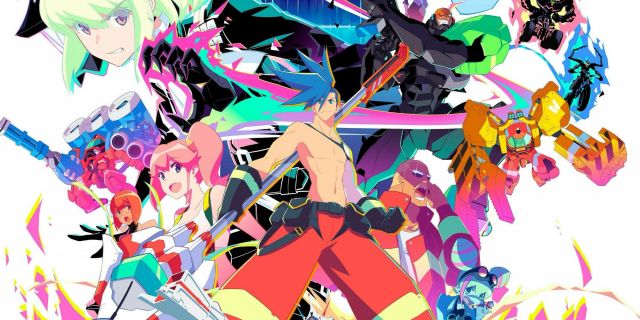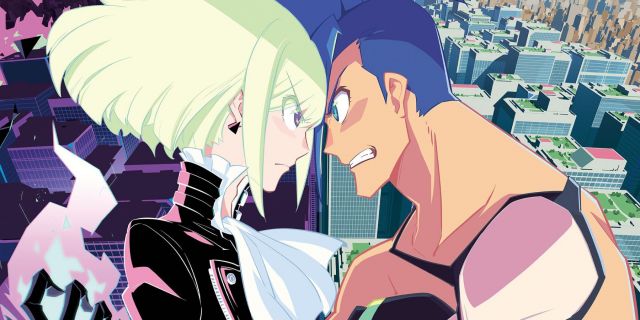Highlights
- Promare, a film by Studio Trigger, is a wildfire of a movie with an action-packed storyline and visually stunning art design.
- The iconic duo of Galo and Lio in Promare symbolizes a balance between fire and ice, passion, and protection, leading to a unique story.
- Through colorful art design, distinct themes, and queer undertones, Promare delivers a unique and visually striking anime experience.
|
Title |
Promare |
|
Director |
Hiroyuki Imaishi |
|
Studio |
Trigger |
|
Premiere Date |
5/19/2019 (Tokyo Premiere) 5/25/2019 (Theatrical Release) |
Maybe it’s because the pandemic warped everyone’s perception of time for two whole years, but it’s hard to believe that Studio Trigger’s Promare turned five years old just this past month. This occasion naturally led fans to revisit the work and recall how this film took the anime community by storm, and to no one’s surprise, this firefighting action film still holds quite the spark.
Promare was released in theaters in Japan on May 25, 2019, directed by Hiroyuki Imaishi and written by Kazuki Nakashima, with designs by Shigeto Koyama, and music by Hiroyuki Sawano. It was the dream team behind 2007’s Gurren Lagann and 2014’s Kill la Kill, reunited to create something just as big, bold, and utterly beautiful, but this time on the big screen.
What if Firefighters… But with Mechs?

Promare envisions an Earth where a portion of the human population awakens to destructive fire-wielding powers, who become known as the Burnish. The ensuing chaos and discrimination against the Burnish create a calamity known as the Great World Blaze, which wipes out half of the world’s population. The story begins in earnest years later in the city of Promepolis, the epicenter of technology built to fight the fire of the terrorist group known as Mad Burnish.
The film follows Galo Thymos, a member of an advanced firefighting unit called Burning Rescue, whose ambition to protect the innocent is exceeded only by his loudmouthed bravado. After responding to a crisis, he finds himself face-to-face with the leader of Mad Burnish, Lio Fotia. Little do they know that these star-crossed rivals will end up working together when Galo finds out the truth behind the Burnish and what his government has done to them.
This Film Has No Chill
As expected of Imaishi and Nakashima’s storytelling style, Promare is a wild film; one written with a self-aware outlandishness that will be endearing for many if a bit aggravating for others. Their stories are loud, bombastic, and throw subtlety to the wayside, yet remain thematically rich on account of their consistent and inspired visual motifs, often fixated around a core idea. Gurren Lagann had drills. Kill la Kill had fabric and scissors. Promare has fire and ice.
Promare has famously drawn a lot of comparisons to its predecessors much in the same way that Kill la Kill was compared to Gurren Lagann when that show came out. Likewise, it does incorporate key ideas from both of these stories, like Gurren Lagann‘s takes on masculinity or Kill la Kill‘s duality, all in the service of telling a new story about rebellion and what it means to burn brightly. Where it most differs from a storytelling perspective is its narrative structure.
For a film eight minutes shy of a two-hour runtime, Promare moves at a bizarre pace that feels engineered to make time fly by. It front-loads so much of the necessary world-building and character drama that by the midway point, it feels like the latter 60% of the movie is pure climax. It puts that much more pressure on the opening act to get audiences invested and makes it all the more impressive that the film kinda nails it.
Promare’s Burning Soul Wins Out

Compared to Imaishi’s TV shows, this film has much less time to establish a foundation before commencing the gradual build consistent with his other stories. The cold open and the introductory action sequence all pull their weight in gold to establish these characters, the central conflict, and the politics at play within Promepolis. The price to pay is some corny exposition following the opening salvo, but it gets away with a lot, thanks to its tone and the story’s great pacing.
There’s not nearly enough time to flesh out the supporting cast compared to Imaishi’s TV shows, but Galo and Lio work perfectly as a duo. They are at opposite ends of their society’s imposed order, but as early as their first encounter outside of battle, they realize they’ve misunderstood each other. Upon being called out by Lio, Galo realizes his perspective on the Burnish is more influenced by dogma than he thought. He apologizes, something Lio isn’t quick to dismiss.
Galo and Lio are Trigger’s Most Iconic Duo
It’s one of the few moments of subtlety in this script, and it pays off later when the two work together. Their chemistry comes naturally. The motif of fire and ice isn’t just an aesthetic comparison, but an ideological one. Fire is associated with destruction, but the act of “burning brightly” evokes not only youth but passion for one’s ideas. Conversely, firefighting and its association with water/ice evoke a desire to protect life from fire’s destruction.
Both Galo and Lio embody a balance between fire and ice, from their shared respect for life and their equally fiery souls. That Galo begins his journey embracing this duality without thought speaks volumes about his character. He’s regarded as an idiot at times – and he certainly can be – but even if he isn’t the smartest, there’s worth in the words of a man who speaks from the heart. Promare is a story about listening to one’s soul, especially when it comes to fighting for others.
The Colorful, Chaotic, and Queer Art of Promare

Of course, it’s difficult to discuss Promare‘s story and message in isolation from its art design. Not only is it the lifeblood of the film, but the vehicle through which this story discovers the above-described depth within its ideas. The Yoshinori Kanada style inherent to Japanese animation – that Trigger has preserved so thoughtfully – is on full display. Not a single pose is without character and not a single scene is without a moment worthy of being a wallpaper.
Trigger’s expected qualities are accompanied by some impressive and – at the time – groundbreaking CGI courtesy of Studio Sanzigen. The qualifier there is only to say that CGI in anime has only gotten better in time since and some of the 3D might look a bit choppy. At its best, though, it gives the vibe of a Guilty Gear cutscene, and these sequences are directed with an adept hand, creating some of the most unique action to come from Studio Trigger.
How Promare Uses Simple Shapes To Leave a Big Impression
Perhaps one of the most underrated tools in Promare‘s arsenal is its command of color and shape to convey its narrative. The former comes through clearly enough – it’s a very colorful film after all. However, the bisexual lighting combined with the deliberate and consistent association of geometry with particular subjects opens up a wealth of interpretations upon rewatch. Rebecca Black of Medium.com wrote an exceptional piece breaking this down, linked below.
While not explicitly stated to be an intention by the creators, Promare also reads as a particularly queer film. This is not only because of the choices made within the art design but also those qualities in tandem with the presentation of rebellion, to say nothing of Galo and Lio’s chemistry through the visual language. It helps that the official art of them together is pretty blatant.
There’s so much more to be said about Promare. Sawano’s score is epic, as are the two themes by Superfly – especially “Kakusei.” Its English dub is great; Johnny Yong Bosch is fantastic as Lio, and revisiting such a stellar performance from the late Billy Kametz as Galo was beautiful and tragic. There’s more still, but like the film itself, it’s often hard to articulate beyond the sheer feeling of it. Five years later, Promare might not be a perfect film, but it never fails to set the soul ablaze.
Source: Medium.com











Leave a Reply